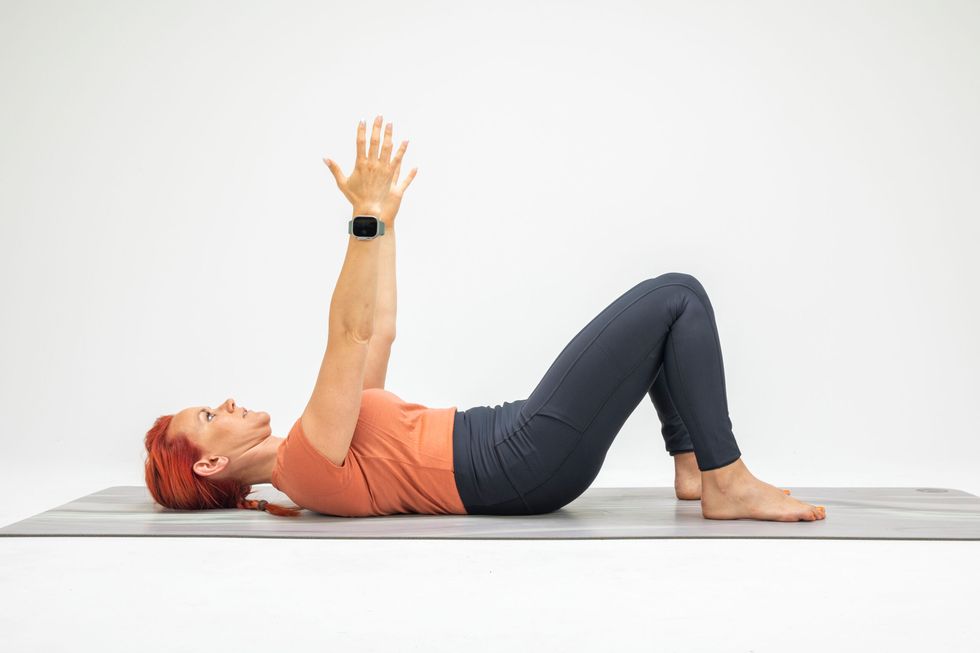5 Sciatica Exercises to Help You Avoid Aches
What you need to know about dealing with this painful condition — and what symptom means you should seek medical help ASAP.
If you’ve ever dealt with sciatica, you know it can be a big pain in the butt… or lower back, legs, and even toes. Because the ache stems from a nerve that runs from the base of your spine all the way to the sole of your foot, the pain can cover a large area. In fact, it often starts in your back or butt and radiates down your leg.
That radiating pain is a telltale symptom of sciatica, but knowing how to treat it is far less straightforward. “Without a proper diagnosis, runners often self-treat and either make the pain worse or don’t get any relief because they aren’t treating the source of the injury,” warns Dr Anh Bui, a former collegiate runner, doctor of physical therapy, and biomechanics specialist.
Read on for some warning signs that you might be suffering from this painful condition, what might be causing your pain, and moves that could help nix your aches for good.
What is sciatica?
Sciatica is pain that comes from an irritated sciatic nerve, the largest nerve in your body. It’s a thick nerve bundle that originates from the low back and supplies the muscles all the way down the back of your leg, through your hip and thigh, down to your foot.
Symptoms include that radiating pain, but also numbness or tingling pain from the butt into the back of the leg. It often includes lower back pain, but don’t assume that sciatica isn’t to blame if you aren’t experiencing back aches, says Bui; depending on where your sciatic nerve is being aggravated, your back might feel totally fine.
What causes sciatica?
That’s the big question you’re facing when you’re suffering from sciatica pain because the root causes are varied — and whatever is contributing to yours affects how it should be treated.
A bulging or herniated disc in your spine is the most common cause of sciatica among the general population, along with bone spurs along the spine. Tumors are a less likely culprit. And runners tend to look at another underlying issue entirely.
“People in the running community often assume sciatica is caused by a tight piriformis compressing the sciatic nerve underneath, more commonly known as piriformis syndrome,” says Bui. This could be a contributing factor, she says, but addressing the piriformis alone isn’t always enough: “In reality, a tight piriformis in runners is often a weak and overused piriformis that is compensating for a very weak and lazy glute. It’s a small hip external rotator that is taking on too much work for a bigger hip external rotator — a.k.a. the glutes — that isn’t doing enough work.”
What should you do to stop the pain?
First things first: With any ongoing ache or pain, seeing a doctor and/or physical therapist is important — but especially so with sciatica. If you notice weakness in the leg or foot drop (i.e., dragging your foot or having trouble lifting the front of it), Bui advises seeking help as soon as possible to avoid permanent nerve damage. Otherwise, you should still see a doc if you’ve been feeling pain for a week or two.
The good news is, sciatica doesn’t have to be chronic if it’s treated adequately for the cause — and to do just that, having a thorough exam and personalised treatment plan is crucial.
Your pain might be so bad that running is the furthest thing from your mind — in which case, yes, take all the time you need to recover. If you’re thinking of lacing up your sneaks, you might be able to continue running while you’re working through sciatica pain. But again, it depends on the cause of your aches.
“If a nerve root at the spine level becomes impinged or aggravated due to a bulging disc, decreased intervertebral disc height, or arthritis, running may aggravate it if you don’t have enough core strength to stabili e the spine and pelvis,” explains Bui. “On the other hand, if sciatica is caused by muscle tightness compressing the nerve, running at a lower intensity may alleviate symptoms by bringing blood flow to the muscles to help them relax.”
Bui advises that you can continue to run if all activities of daily living are pain free; you can maintain your normal running gait; you’d rate your pain level no more than 3 out of 10 during and after running; and your symptoms improve with running and movement. Just remember to keep your outings easy — you probably don’t feel like speedwork at the moment anyway, but now’s not the time for pushing through sprints or up hills.
Finally, some good PT exercises can help you bounce back. Here are some strength moves and stretches that often help ease sciatica by mobilising and decompressing the nerve, while strengthening your core and glutes to help stabilise your spine and pelvis. Just make sure to get the okay from your doc before adding these sciatica exercises to your routine.
5 Sciatica Exercises to Add to Your Injury-Prevention Routine
1. Sciatic Nerve Glide
Lie faceup with knees bent and feet flat on floor. Raise right knee toward face and grab behind right thigh with both hands. Keeping right foot flexed, slowly straighten leg toward ceiling, hold for two counts, then bend again. Repeat for 15 reps. Then switch sides.
2. Bird Dog
3. Glute Bridge

4. Clamshell
Lie on left side with knees bent and stacked. Prop up torso with left forearm on floor. Lift right knee, keeping feet together. Lower. Repeat. Do 8-15 reps. Then switch sides. To make this more difficult, loop a resistance band just above knees.
5. Pelvic Tilt
Lie faceup with knees bent, feet on floor. Flatten lower back against floor by tightening abdominal muscles and bending pelvis up slightly. Hold for two counts, then lower pelvis to start. Repeat. Do 10-15 reps.
READ MORE ON: back pain butt pain sciatica strength exercises










